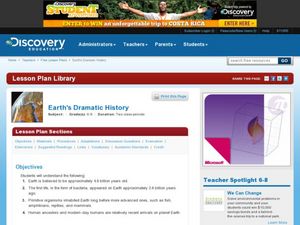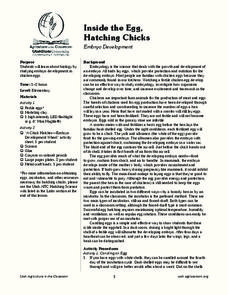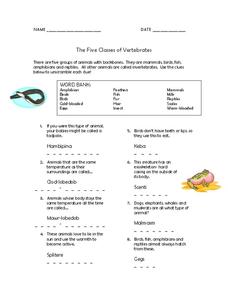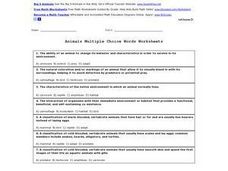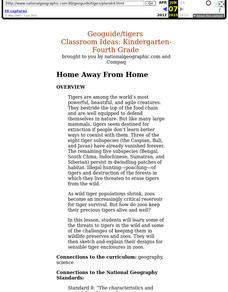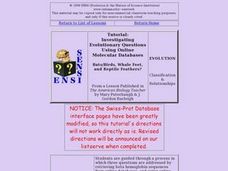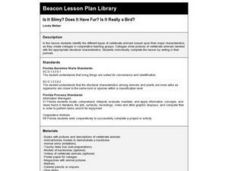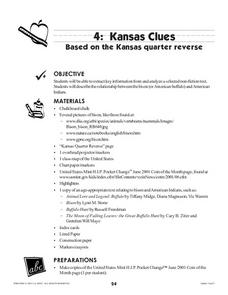Curated OER
Addition with Regrouping
In this regrouping in addition worksheet, students use the table for the 'Threatened and Endangered Animals' and their numbers to solve the addition problems that utilize regrouping.
Curated OER
Middle and Recent Earth History
In this middle and recent Earth history instructional activity, students are given 20 statements about the changes in the Earth and life on Earth and they determine if they are true or false. If the statements are false, students change...
Curated OER
Fur and Feathers
In this word scramble worksheet, students unscramble words that are names of animals with fur or birds with feathers. Students write 10 answers.
Curated OER
Squirrel Islands
In this adaptations worksheet, young scholars read about 3 species that have changed over time to adapt to their environment. Students design a squirrel that has adapted to an island habitat that young scholars are assigned. They...
Curated OER
Geologic Time Scale
For this geologic time scale worksheet, students are given a list of terms and eras which they use to complete a time scale. They classify organic and inorganic changes that took place in the Precambrian era, the Cenozoic era, the...
Curated OER
Bats and Boas Abound
Students investigate Puerto Rican boa constrictors and bats. For this animal science lesson, students read an article about the bats and snakes found in Puerto Rico. Students use various art supplies to create a diorama of the habitat of...
Curated OER
Creating a Food Web
Students investigate hunters and prey by creating a food web. In this animal life lesson, students investigate a single organism in preparation for a field trip, discovering its diet and habitat. Students each discuss their animal with...
Curated OER
Fearsome Creatures 1
In this wild animals worksheet, students fill in the blanks or choose the correct words to sentences about wild animals. Students complete 47 blanks.
Curated OER
Earth's Dramatic History
Middle schoolers create a timeline. In this Earth's History lesson, students research the history of life on Earth and use the information collected to create a timeline. Middle schoolers also answers the provided discussion questions.
Curated OER
Inside the Egg, Hatching Chickens
Students explore how an egg becomes fertilized. In this biology instructional activity, students "candle" a variety of eggs in order to determine which ones have been fertilized and which ones haven't. Student use paper plates to create...
Curated OER
The Five Classes of Vertebrates
In this vertebrates classification worksheet, 5th graders unscramble 15 words to find answers to clues. Each clue gives information about the characteristics of vertebrates.
Curated OER
Animals Multiple Choice Words Worksheet
Looking for some simple multiple-choice questions for an upcoming biology unit on animals? This worksheet features 7 clearly worded questions, each with 4 possible answers. Topics include adaptation, camouflage, ecosystems, animal...
Curated OER
Oil Spill in a Test Tube
Students develop a test tube model of an oil spill in order to experiment with conditions needed for bioremediation. They apply the principals of experimental design by analyzing a research article on the EXXON Valdez bioremediation...
Curated OER
Home Away From Home
Students discover some of the threats to tigers in the wild and some of the challenges of keeping them in wildlife preserves and zoos. They then sketch and explain their designs for sensible tiger enclosures in zoos.
Curated OER
Investigating Evolutionary Questions: Bats, Whales, Reptiles, Birds, Animal Classification
Students are guided through a process in which three questions are addressed by retrieving beta hemoglobin sequences from online databases, and using online tools to compare those sequences in student-selected animals.
Curated OER
Pets: Oh Behave
Students develop an understanding of how innate and learned behaviors and the environment determine behavior. They see how a variety of factors affects our pet's behavior-including species-specific traits, the environment, training, and...
Curated OER
Draw T. rex
Students explore how scientists determine what prehistoric animals looked like based on their bones. They draw a picture of the skull of a Tyrannosaurus Rex by copying an image from an overhead or book.
Curated OER
Creating a Classification System
Students create classification system for Arctic-dwelling animals, the Arctic hare in particular.
Curated OER
Is It Slimy? Does It Have Fur? Is It Really a Bird?
Sixth graders identify the different types of vertebrate animals based upon their major characteristics, as they create collages in groups. Collages show pictures of vertebrate animals labeled with the appropriate structural...
Curated OER
Roadkill Museum
Students use roadside kill to use taxidermy skills, become comfortable working with animals and dissecting.
Curated OER
Explore: Third Grade Scents
Students use the olfactory sense to determine if a marker is appropriate 'food' or not. This experience helps students explain why so many animals rely on the sense of smell to find prey.
Curated OER
Kansas Clues
Learners examine the Kansas state quarter and the Buffalo nickel and look for clue to help them identify why the bison was so important to the Native American. They perform "freeze frames" depicting Native American use of the bison.
Curated OER
Drama in the Refuge
Students write and perform dramatic presentations about the Arctic National Wildlife Refuge. They select formats from puppets, plays, improvisational skits, or screened silhouette.
Curated OER
Frogs Losing Ground
Learners explore an exhibit through an interactive program on frogs. They can listen to the different sounds frogs make and the different types of frogs. They search for the types of frogs they find in their local area.
Other popular searches
- Ocean Mammals
- Characteristics of Mammals
- Marine Mammals
- Mammals and Fish
- Animals Mammals
- Land Mammals
- Mammals (Wildlife)
- Prehistoric Mammals
- Mammals Word Search
- Mammals Crossword
- Sea Mammals
- Ocean Mammals 1st Grade










